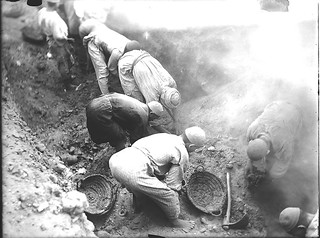
PREV ARTICLE
NEXT ARTICLE
FULL ISSUE
PREV FULL ISSUE
ANCIENT EGYPT'S MOST LITERATE TRASH HEAP
Bibliophiles should apreciate this Atlas Obscura story of a treasure trove of literature found in an ancient Egyptian garbage
dump. Here's an excerpt. Be sure to read the complete article online. -Editor
Oxyrhynchus is something special. It's in a desert where it never rains, and it's well outside any river's flood plain. It was a multi-cultural crossroads which was alternately part of the Nubian, Persian, Greek, Ptolemaic, Roman, Byzantine, and Fatimid empires. It held some of the earliest Christian monasteries and one of the oldest Egyptian mosques. Most importantly, it was a dumping ground for hundreds of thousands of pieces of papyrus—a wide-ranging library of classical texts, official records, personal correspondence, and grocery lists. It's basically the closest thing we have to discovering the Library of Alexandria in a landfill. Academics familiar with it throw around terms like "unparalleled importance" and "holy grail" and aren't trying to be hyperbolic. It contained a lot of other ancient literature that would otherwise be totally lost–most famously a Sophocles comedy and the poetry of Sappho–not to mention extensive details about everyday life in Egypt, Greece, and Rome. It also held the biggest cache of early Christian manuscripts ever discovered. Papyrus is much more durable than the wood-pulp paper we use today—durable enough to survive for 2,000 years. That alone wouldn't matter if it weren't for papyrus's other advantage: unlike vellum or parchment, it was cheap. As a result, although literacy in Ancient Egypt wasn't widespread by modern standards, the people who were able to write were able to write a lot, to such an extent that bureaucratic note-taking became its own cultural imperative—and that writing stuck around, at least partly because it wasn't expensive enough to be worth stealing or repurposing. (It did sometimes make good packing material, notably to wrap mummies.) After more than a hundred years of steady effort by hundreds of scholars, we are still nowhere near transcribing everything that came out of the ground in that single decade. Nor the additional papyrus found by Italian digs in the 1920s and 1930s. Nor the further recovery by a Kuwaiti team in the 1980s. The Oxford Archives have invited anyone with an internet connection to join the deciphering team. You don't even have to be able to read Greek (or Pahlavi, or Coptic, or Arabic, or Persian). All you have to do is visit the Ancient Lives site, look at scans, and press the letter buttons that resemble the shapes you see. Or maybe you could take the trash out to the curb, and congratulate yourself on building one small piece of a future Oxyrhynchus To read the complete article, see:
Wayne Homren, Editor The Numismatic Bibliomania Society is a non-profit organization promoting numismatic literature. See our web site at coinbooks.org. To submit items for publication in The E-Sylum, write to the Editor at this address: whomren@gmail.com To subscribe go to: https://my.binhost.com/lists/listinfo/esylum All Rights Reserved. NBS Home Page Contact the NBS webmaster 
|
